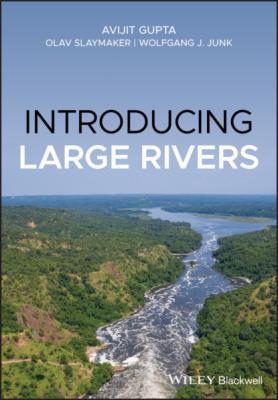ТОП просматриваемых книг сайта:
Introducing Large Rivers. Avijit Gupta
Читать онлайн.Название Introducing Large Rivers
Год выпуска 0
isbn 9781118451434
Автор произведения Avijit Gupta
Жанр География
Издательство John Wiley & Sons Limited
These figures vary between sources, although perhaps given the dimensions, such variations are proportionally negligible. Discharge and sediment figures are from Meade (1996) and Gupta (2007) and references therein. Drainage areas are rounded off to 106 km to reduce discrepancies between various sources. The Nile is not listed, even though it is 6500 km long. It does not qualify for this table as its water and sediment discharges are relatively low.
The great lengths of these rivers allow them to flow across a range of environments. The Mekong, for example, flows on both rock and alluvium, looking different (Figure 1.2). The end part of the river needs to adjust to all such environmental variations plus the Quaternary changes in sea level.
Fluvial geomorphology generally is based on small and logistically manageable streams. A study of large rivers is necessary, although difficult, for multiple reasons. Large rivers form and modify subcontinental-scale landforms and geomorphological processes. A high number of them convey and discharge a large volume of water and sediment to the coastal seas. An understanding of modern large rivers helps us to explain past sedimentary deposits. Large rivers, such as the Amazon (Mertes and Dunne 2007), and their deposits may reveal basinal and regional tectonics, past and present climate, and sea-level fluctuations. Management of the water resources of a large river is often an essential step toward the supply of water and power to a large number of people. We need to study large rivers for many such reasons.
Figure 1.1 A sketch map showing the location of 24 large rivers in the world: 1, Amazon; 2, Congo; 3, Orinoco; 4, Ganga-Brahmaputra; 5, Changjiang; 6, Yenisei; 7, Mississippi; 8, Lena; 9, Mekong; 10, Parana-Uruguay; 11, St. Lawrence; 12, Irrawaddy; 13, Ob; 14, Amur; 15, Mackenzie; 16, Zhujiang; 17, Salween; 18, Columbia; 19, Indus; 20, Magdalena; 21, Zambezi; 22, Danube; 23, Yukon; 24, Niger.
1.2 A Book on Large Rivers
A number of individual large rivers have been studied and such studies published discretely. A collection of advanced essays on the general characteristics of large rivers, their selected case studies, and their utilisation and management is also available (Gupta 2007). In comparison, this volume is primarily an integrated textbook on large rivers and introduces the reader to the morphology and management of these huge conduits on which both the general physiography of the basins and utilisation of the resources of the rivers depend.
The discussion on large rivers starts with an account of their geological framework (Chapter 2) that determines where they can be located and also what their physical characteristics would be. The geological framework of a large river is based primarily on large-scale tectonics commonly driven by plate movements. An uplifted zone and the adjoining subcontinental-scale water catchment area are necessary requirements for a big river. Smaller tectonic movements may further modify the basin and the channel and explain their detailed morphological characteristics.
Figure 1.2 The Mekong. (a) On rock, downstream of Chiang Saen, northern Thailand. (b) On alluvium near Savanakhet, Lao PDR, photographed from the air. Note the difference in form and behaviour between the two reaches. Large rivers commonly are a combination of a number of similar variations.
Source: A. Gupta.
The regional geology should create a drainage basin large enough to accumulate enough precipitation to support and maintain the big river. Chapter 3 discusses the nature of water and sediment in a large river. The discharge in a large river is determined by various climatic criteria depending on its location: annual rainfall, seasonality in rainfall, and high episodic rain from synoptic disturbances such as tropical cyclones. The supply of water to large rivers could be from almost all parts of the watershed but the sediment supply generally is associated selectively with high mountains. For example, the discharge of the Orinoco is collected from most of the basin, irrespective of geology or relief, but its sediment supply is only from the Andes Mountains and the alluvial Llanos plains formed near the Andean foothills. In certain cases, several large rivers flow through arid landscapes without identifiable addition to their discharge but manage to sustain their flow because of the high discharge arriving from the upper non-arid parts of their drainage basins. Sediment in flood moves in large rivers both in downstream and lateral directions if large floodplains are present. The sediment grains travel a long distance to reach the sea and, in the process, become mature and sorted.
Large rivers have been aptly described as massive conveyance systems that move detrital sediment and dissolved matter over transcontinental distances (Meade 2007). Their morphology is dependent on regional geology, discharge and sediment flux, and may change several times between the headwaters and the sea (Chapter 4). Morphologically a large river usually has a channel flanked by bars, floodplain, and terrace fragments. The channel pattern depends on the gradient of the river and the nature of water and sediment it transports, and the pattern varies among different rivers as they adjust to the local physical environment. Floodplains of large rivers are important not only for their origin and age but also for their ecology which supports a wide variety of species, and their economic utilisation by people. The role of flood pulses in the maintenance of the floodplains and its ecology is crucial. This is discussed in detail by Junk et al., in one of the two invited chapters in this book (Chapter 5). The huge discharge

